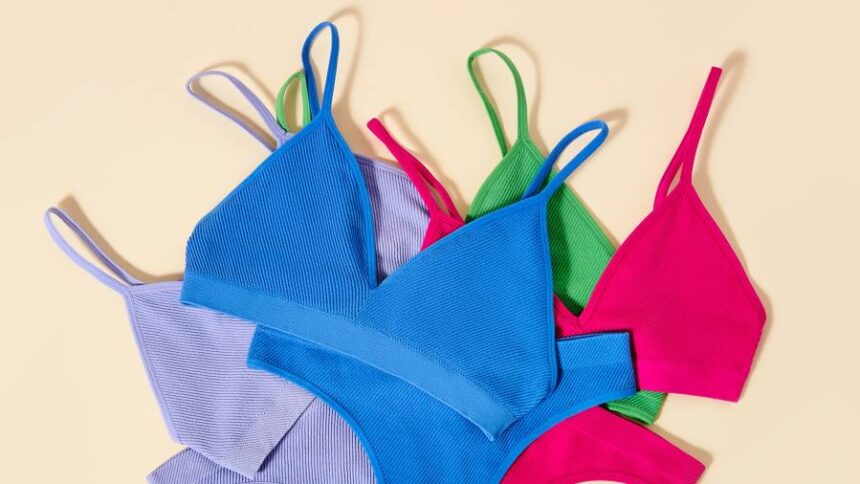Receive free Life & Arts updates
We’ll send you a myFT Daily Digest email rounding up the latest Life & Arts news every morning.
Last week I bought a bra in Primark. Part of the retailer’s “Primark Cares” range, the garment was made in China and contains 50 per cent recycled nylon. But I was not charmed by its “green credentials” nor its rock-bottom price — I just liked the way it looked. It didn’t squeeze my bosom into pneumatic missiles, contort with painful underwiring, nor decorate my absence of cleavage with itchy lace.
The cut, the fit and fabric were seamless — it was the perfect shape. A set of bra and knickers cost £6. I gave my daughter the matching thong.
Shopping for anything in 2023 brings with it some degree of guilt. As a former fashion editor, and now editor of a consumer title that preaches the gospel of investment and artisanship, I know the grim statistics: we dump about 92mn tons of clothing in landfills every year, and only 20 per cent of textiles are collected for reuse or recycling globally.
This fast-fashion venture was a rare occasion, I have been conditioned to consider it a basic ill. And while impulse shopping was a staple activity throughout my twenties and thirties, I have since learnt to exercise restraint. However, I’ve worn the bra most days since and it washes really well. It is not, as is assumed of most mass-produced items, something I consider “throwaway”. I could have bought a far pricier item by a big brand, or some celebrity designer name. But price is no guarantee that something is made in any more ethical or green an environment, especially when it comes to lingerie.
While the high street has become the bogeyman of the hand-wringing classes, it can still offer excellent value. My wardrobe sways with designer garments, many so precious to me they are barely ever worn. By contrast, the items on permanent rotation are a trio of T-shirts I bought 15 years ago from Uniqlo.
If I cherish something and wear it often, does this give more credence to my cheapo bra? Rachel Arthur, sustainability consultant and writer, gives me the hard no. “You are helping to contribute to the climate and ecological crisis by buying cheap items that do not take into consideration the true cost of producing them — the carbon, water, pollution impacts. It will release microplastics into the waterways with every wash it has.”
Tiffanie Darke is writing a book on sustainable wardrobing and the dilemmas at its core. In an effort to draw attention to our toxic landfill habit, she signed up in January to buy only five fashion items this year. She describes my bra’s journey with brutal precision, beginning with the environmental footprint required to produce even recycled nylon (never mind the virgin nylon) and ending with the tiny metal fastenings, which will never decompose. She also prompts me to contact Primark to verify the bra’s supply chain. A spokesperson writes back, very quickly: “Primark have been making these products for three years now and they are currently our bestseller in lingerie. The bras are sourced from two long-term suppliers in China . . . and, while the majority of factories we work with also manufacture for other brands, we only partner with those who meet the standards set out in the Primark Code of Conduct.”
Darke does acknowledge that lingerie is an especially thorny issue in the sustainability arena, as the current alternatives are poor: things fall apart after a few months or fail to offer the right support. “One of the biggest issues is performance,” she says, “and things like bras and sneakers require the best of all.”
Shopping has become deeply divisive as habits are categorised as “good” or “bad”. The good shopper spends a premium on clothes that have a low environmental impact: the person who buys £2 bikinis on the high street is considered bad. But surely it’s just as toxic to judge behaviours that are largely driven by one’s means. Besides, as Darke points out via “The Great Green Washing Machine Part 2” by Veronica Bates Kassatly and Dorothée Baumann-Pauly, sustainability metrics in fashion are often misused anyway.
“Clothes are supposed to be worn multiple times, and if some garments are worn many times more than others then that should be included in sustainability calculations,” she says. “If a dress ‘costs’ 12, whether that is US dollars or an environmental measure, and worn once, the cost is 12 per wear. If another dress ‘costs’ 1,200, and is worn 100 times, the cost/impact is also 12 per wear. The difference is that at the end of those 100 times, in the first case there are 100 dresses to dispose of, and in the second, only one. To return to the sage advice of the late, great Vivienne Westwood: ‘Buy less, choose well, make it last.’”
Choose well and make it last was the mantra of my childhood, where generations of my family knitted, stitched and sewed their own clothes. I was unfortunately part of another generation that came of age during the great Top Shop boom. I still think of shopping as a micro-hobby: it’s such an easy hit of dopamine.
I hardly dare admit I went back to Primark last weekend and bought two — OK, then, four! — more sets. In order to justify this purchase, I realise, I’ll have to be buried in this goddamn bra.
Email Jo at jo.ellison@ft.com
Find out about our latest stories first — follow @ftweekend








